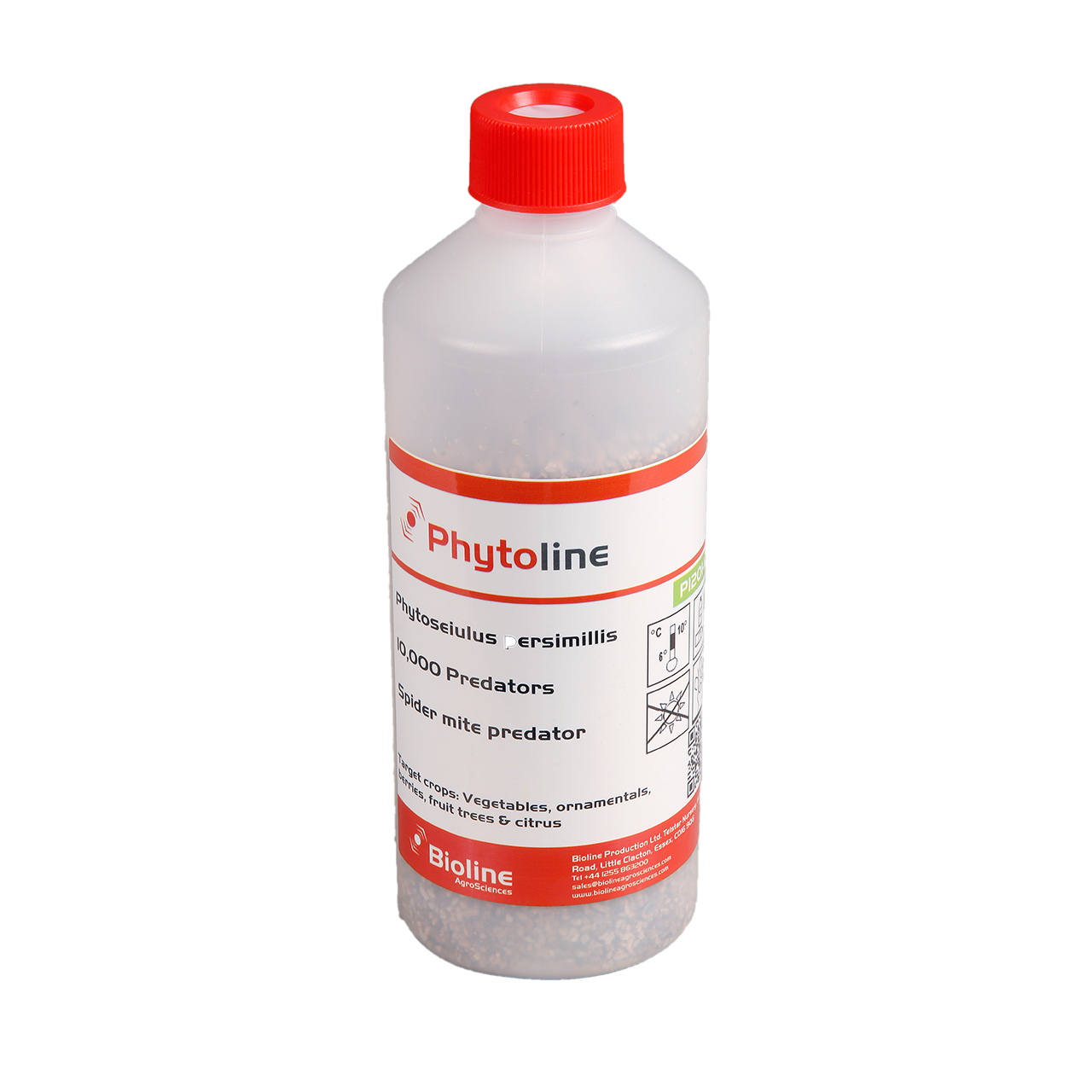Spider mite (Tetranychus urticae);
Tetranychus turkestani (Tetranychus atlanticus);
Carmine spider mite (Tetranychus cinnabarinus).
Cucumber, tomato, eggplant, ornamental crops (gerbera, etc.), roses, citrus crops.
250 ml bottle contains 2,000 individuals in vermiculite, with red ventilated cap.;
500 ml bottle contains 10,000 individuals in vermiculite, with red ventilated cap.;
30 ml vial contains 2,000 individuals, with flip-cap.
It is an extremely small predator (approximately 0.3 – 0.5 mm). The adult female is up to 0.5 mm in length, teardrop-shaped with a thin elastic body cover. It is orange to light red, has long legs. The male is slightly smaller than the female. The body is divided into two sections: the gnathosoma and the idiosoma. The gnathosoma is the part of the body comprising the mouth and feeding parts, and the idiosoma is a large region that bears the legs, the genital and anal openings, and an assortment of tactile and sensory structures.
The life cycle passes through successive phases of development: egg, larvae, protonymph, deutonymph, adult (female or male).

The females lay eggs in pest colonies, attached to the pest web or directly to the leaf surface. Eggs are oval, pale pink, approximately twice as large as the pest mite ones. (0.21 mm x 0.18 mm).
Six-legged larva (0.17-0.2 mm) appears from the egg and eats off the embryonic yolk. After hatching, the larva places near the empty eggshell, goes into a state of dormancy, which ends with molting.
After the first molt, an eight-legged protonymph (the 1st instar nymph) appears. Protonymph feeds on spider mite eggs, eats from 5-7 prey pieces within its development per day. When feeding is stopped, the protonymph molts into a deutonymph (the 2nd instar nymph). From previous stages, deutonymph differs in extreme voraciousness and mobility. This phase lasts 1 day, within which deutonymph kills from 9 to 16 eggs. The development cycle ends with the appearance of the adult mite.
.
| Instar of development | Time of pre-imaginal development (days) at a constant temperature ° С | |||
|---|---|---|---|---|
| 15 ºС | 20 ºС | 25ºС | 30 ºС | |
| RH – from 36 to 95% | RH – 70% | |||
| Egg | 7,5 | 2 | 1 | 1,5 |
| Larva | 4,1 | 1,5 | 0,5 | 0,7 |
| Protonymph | 6,2 | 1,7 | 1,2 | 1,1 |
| Deutonymph | 10,2 | 3,8 | 1,1 | 1,7 |
| Total | 28 | 9 | 3,8 | 5 |
At a favorable temperature of + 25 …+ 30 ° C, the relative humidity of 70% and higher the development time from egg to adult is 3.8-5 days, which is 1.5-2 times faster than spider mites’ ones. The adult female lays an average of 50-80 eggs during its lifetime and consumes 30 pest eggs or more than 24 adults.
| Temperature, ºС | Generation time, days | Development time ratio | |
|---|---|---|---|
| predator | pray | ||
| 13 | 18,7 | 36,1 | 1:1,9 |
| 18 | 11,5 | 21,4 | 1:1,9 |
| 23 | 8,2 | 13,1 | 1:1,7 |
| 25 | 6,0 | 9,5 | 1:1,6 |
| 27 | 5,5 | 8,2 | 1:1,5 |
| 30 | 4,9 | 7,2 | 1:1,5 |
| 35 | – | 5,9 | – |
Ph. persimilis is a fast-moving predator. First of all, it searches a pray (mite T. urticae) due to the presence of web on the leaf surface. The spider mite web helps to find the pray quickly. Having found the web phytoseiulus persimilis looks for eggs, larvae, and T. Urticae adults hard. Here in the web the female deposits eggs, where its offspring hatches. P. Persimilis has high migratory ability. In general, prey searching can be divided into 3 phases: 1) search for spider mite places in the habitat, 2) search for spider mite colonies on the area, 3) search for spider mite species in the colony.
While searching, phytoseiidae focus on volatile plant substances induced by phytophages, even in distant prey habitats, and they are retained by this stuff. The speed of approaching prey strongly depends on the predator movements. Probably, the victim’s eggs are found by the predator through the contact of mechanoreceptors and chemoreceptors on its front legs. If sensory data from the legs indicate the presence of prey, then the predator contacts the egg by its mouthparts and palpates it with the pedipalps.
Chemoreceptors on pedipalps respond to the food stimulus from the outside of the spider mite egg. The predator penetrates the egg with its chelicerae. Adult females kill up to 30 eggs and up to 20 growing pests per day. If there are enough pests, phytoseiullus mainly consumes large individuals and nymphs. Phytoseiullus leave some eggs and nymphs to feed their offspring and move to new infestation areas.
| Infection degree | Prevention | Doses of the application by infection degree | ||
|---|---|---|---|---|
| Small | Average | High | ||
| Phytoseiulus persimilis вермикулит | 3-4 ind/m² | 10-15 ind/m² | 15-20 ind/m² | >30 ind/m² |
| Interval, days | once in a month | in a week | weekly | weekly |







Оставить комментарий